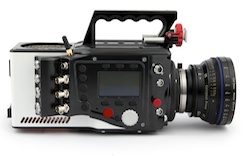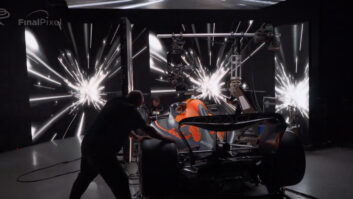
Vision Research unveiled a 4K version of its Flex high-speed camera today for sports replays and cinematic slow-motion sequences. The Phantom Flex4K body will retail between $100-115K (£65,000-£75,500) depending on memory size when it ships from IBC2013.
On preview at NAB is a partially functional camera body, with engineering being finalised and tested over the summer, incorporating feedback from cinematographers. The camera will support both raw and compressed recording formats.
Built upon the Phantom Flex platform, previously a 2K or HD capable unit, the Flex4K features a super-35mm format sensor with a full resolution claimed to be greater than 4K at 4096 x 2304. At full resolution the camera shoots up to 900 frames per second.
At a standard 4K resolution, which is 4096 x 2106, the camera shoots 1,000 fps and still offers the option for greater than 10x slow motion. At 1920×1080 the frame rate increases to 3,840 fps. At 720p the camera shoots at up to 6,000 fps. It also supports standard sync-sound rates at any acquisition speed.
As with other Phantom cameras, the Flex4K uses raw cine files, but it also records compressed files directly in the camera.
For recording media, there will be two options:
– New CineMag hot-swappable proprietary memory called Phantom CineMagIV, available in 1TB and 2TB versions. For ultra high speed shooting, the company recommends recording to the camera’s internal RAM – which is up to 64GB – and then saving the file to the CineMagIV to maximise record time.
– The other option is saving compressed files to a Phantom CineFlash drive. For high-speed capture this is not as fast an in-camera workflow as the CineMag, but it does simplify things when raw files are not required.
The unit comes with a PL mount and is also compatible with Canon EF and Nikon F mounts. Menu buttons are positioned around a display to allow for quick access to the most commonly changed recording parameters. Virtually all settings that are needed to set up and operate the camera are available on the camera body itself.
To monitor the image, there are 2x 3G-SDI outputs and 1x component viewfinder output. The 2x 3G-SDI outputs can output two identical 1080p 4:4:4 signals, or be used together for a 4K 4:2:2 video output.
The viewfinder port currently accepts Sony and Panasonic HD viewfinders, just like the Phantom Flex and Phantom HD Gold, however a new viewfinder is also in development.
A fully kitted out system will come in around $150,000 (£98,500)
Adrian Pennington
www.visionresearch.com







